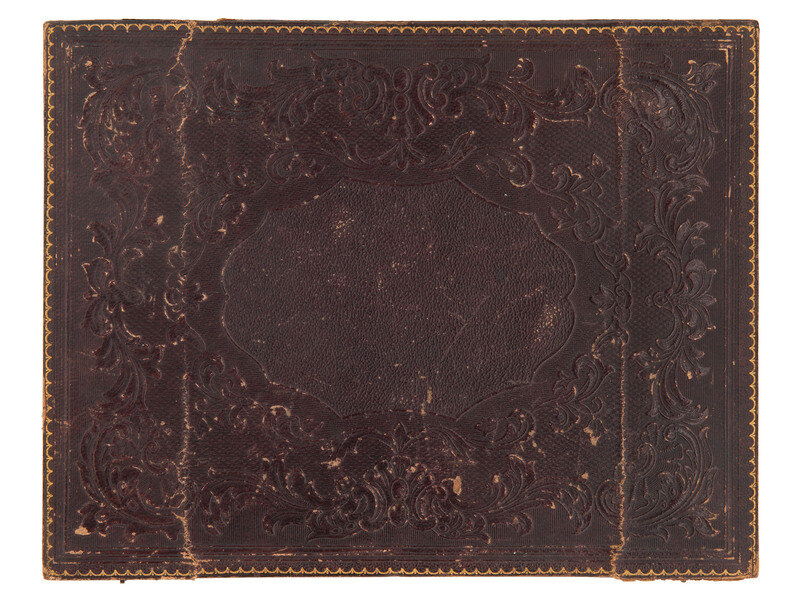Lot 356
[CALIFORNIA - EARLY PHOTOGRAPHY]. Whole plate daguerreotype of San Francisco, California. Circa 1852-1853.
Sale 1344 - American Historical Ephemera and Photography
May 31, 2024
10:00AM ET
Live / Cincinnati
Own a similar item?
Estimate
$30,000 -
50,000
Price Realized
$66,675
Sold prices are inclusive of Buyer’s Premium
Lot Description
[CALIFORNIA - EARLY PHOTOGRAPHY]. Whole plate daguerreotype of San Francisco, California. Circa 1852-1853.
Whole plate daguerreotype capturing the southeast corner of Front and Sacramento Streets in San Francisco at the height of the Gold Rush. This busy corner of the city was located close to the waterfront as evidenced by the ship masts just visible behind the “Ship Chandlery” at left. Clearly visible on the buildings is signage representing commission merchants and importers who offered various wares to fortune-seeking miners. The daguerreotype’s exceptional clarity and contrast also reveal many details within the composition, including figures seated in doorways, horse-drawn carts parked in the street between stacks of barrels, and salvaged ship's timber. (Some tarnishing to edges, at least one notable scratch to immediate left of sign reading "Groceries & Liquors," with other shallower scratches in other areas, occasional spotting, oxidation to mat; resealed 2024.) Housed in a fully separated leatherette case (separated at spine, surface wear).
Though the exact date of this image is unrecorded, evidence suggests it may document the construction of commercial buildings at a prominent and historic San Francisco intersection ca 1852-1853. Cross-referencing the San Francisco City Directories for the years 1850, 1852, 1852-1853, and 1854, with the business signage visible in the daguerreotype, the year can be narrowed to ca 1852-1853 at which time Leffingwell & Co., E.H. Parker, Mills & Vantine, Sweetser & Hutchings, Truett & Truett, and Wm. H. Stowell are all listed between 58 and 64 Front Street. Truett & Truett, which was established in 1849, changed to Miers F. Truett & Co. in January 1853, further solidifying the timeframe to 1852-1853.
Ca mid-1850s illustrations and photographs also place the daguerreotype in context and identify the specific location within the city as the southeast corner of Front and Sacramento Streets. A print entitled "S.E. Cor[ner], Front and Sacramento [San Francisco, California], Erected 1852" (Bancroft Library, James De Fremery collection) shows a bustling street corner and a building configuration that closely matches this daguerreotype. Images associated with the 1856 San Francisco Vigilance Committee present a similar building configuration, though the intersection is notably more-developed along both Front and Sacramento Streets by that time. Charles B. Huestis's engraving "Execution of James P. Casey and Charles Cora, By the Vigilance Committee of San Francisco..." (Town Talk, 1856 ) shows corner buildings closely resembling those on the far left of the daguerreotype, and specifically identifies the location as "Sacramento Street, Between Front and Davis." Notably, the Vigilance Committee's Headquarters along Sacramento Street would occupy the vacant lot visible at the center left of the daguerreotype next to the "Ships Chandlery." An image titled "Old Fort Gunnybag - on south side of Sacramento bet. Battery & Front St. Vigilance Committee of 1856" (Bancroft Library, Cook Scrapbooks Documenting San Francisco History and Law Enforcement) shows the buildings which would soon spring-up to occupy the vacant lot visible in the daguerreotype.
Though the intent of the unknown photographer cannot be certain, it seems that the salvaged ship timbers were the reason for framing the photo. At the height of the California Gold Rush, dozens of ships were abandoned in the harbor. One explanation for the ship lumber on the street blocks from the waterfront is the possibility that the beams came from a dismantled ship and were intended for building construction. This could also explain the large pile of stone at the right side of the plate, perhaps indicative of stones for the foundation of new buildings along Sacramento and Front Streets. Given the prominence of the building materials in the photograph, the image may have been taken to convey the massive transformation that was occurring in San Francisco at the height of the Gold Rush. A once sleepy town of a few hundred had within three years become a booming port city and a thriving economic center. Central to this transformation was the construction of a modern city, a remarkable process encapsulated in this historic image.
A daguerreotype of San Francisco this size and importance has not appeared at auction for nearly 20 years.
This lot is located in Cincinnati.
Condition Report
Auction Specialist













